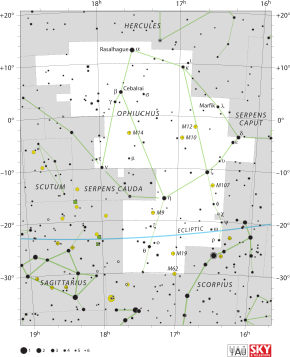
Back Slangdraer (sterrebeeld) Afrikaans الحواء (كوكبة) Arabic اوفيوكاس ARZ Ofiucu AST İlandaşıyan (bürc) Azerbaijani Змееносец (йондоҙлоҡ) Bashkir Змеяносец (сузор’е) Byelorussian Зьмеядзержнік BE-X-OLD Змиеносец (съзвездие) Bulgarian སྦྲུལ་འཛིན་སྐར་ཚོམ་ Tibetan
| Constellation | |
 | |
| Abbreviation | Oph |
|---|---|
| Genitive | Ophiuchi |
| Pronunciation | /ˌɒfiˈjuːkəs/ genitive: /ˌɒfiˈjuːkaɪ/ |
| Symbolism | the serpent-bearer |
| Right ascension | 17h |
| Declination | −8° |
| Quadrant | SQ3 |
| Area | 948 sq. deg. (11th) |
| Main stars | 10 |
| Bayer/Flamsteed stars | 65 |
| Stars brighter than 3.00m | 5 |
| Stars within 10.00 pc (32.62 ly) | 11 |
| Brightest star | α Oph (Rasalhague) (2.08m) |
| Messier objects | 7 |
| Meteor showers |
|
| Bordering constellations | |
| Visible at latitudes between +80° and −80°. Best visible at 21:00 (9 p.m.) during the month of July. | |
Preview warning: Page using Template:Infobox constellation with unknown parameter "ophicues"
Ophiuchus (/ˌɒfiˈjuːkəs/) is a large constellation straddling the celestial equator. Its name comes from the Ancient Greek ὀφιοῦχος (ophioûkhos), meaning "serpent-bearer", and it is commonly represented as a man grasping a snake. The serpent is represented by the constellation Serpens. Ophiuchus was one of the 48 constellations listed by the 2nd-century astronomer Ptolemy, and it remains one of the 88 modern constellations. An old alternative name for the constellation was Serpentarius.[1]
- ^ "Star Tales – Ophiuchus". Retrieved 25 June 2021.